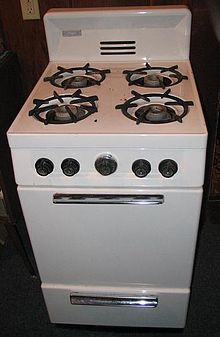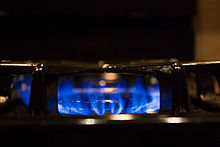- Gas stove
-
In cooking, a gas stove is a cooker which uses natural gas, propane, butane, liquefied petroleum gas or other flammable gas as a fuel source.
Contents
History
The first gas stoves were developed as early as the 1820s, but these remained isolated experiments. James Sharp patented a gas stove in Northampton, England in 1826 and opened a gas stove factory in 1836. At the World Fair in London in 1851, a gas stove was shown, but only in the 1880s did this technology start to become a commercial success. The main factor for this delay was the slow growth of the gas pipe network.
The first gas stoves were rather unwieldy, but soon the oven was integrated into the base and the size reduced to fit in better with the rest of the kitchen furniture. In the 1910s, producers started to enamel their gas stoves for easier cleaning. A high-end gas stove called the AGA cooker was invented in 1922 by Swedish Nobel prize winner Gustaf Dalén.
Ignition
Gas stoves today use two basic types of ignition sources, standing pilot and electric. A stove with a standing pilot has a small, continuously burning gas flame (called a pilot light) under the cooktop. The flame is between the front and back burners. When the stove is turned on, this flame lights the gas flowing out of the burners. The advantage of the standing pilot system is that it is simple and completely independent of any outside power source. A minor drawback is that the flames continuously consume fuel even when the stove is not in use. Early gas ovens did not have a pilot. One had to light these manually with a match [Stove Lighting[1]]. If one accidentally left the gas on, gas would fill the oven and eventually the room. A small spark, such as an arc from a light switch being turned on, could ignite the gas, triggering a violent explosion. To prevent these types of accidents, oven manufacturers developed and installed a safety valve called a flame failure device for gas hobs and ovens. The safety valve depends on a thermocouple that sends a signal to the valve to stay open. If a draft blows out the flame or it goes out due to loss of gas pressure, the thermocouple cools and signals the valve to close, shutting off the gas supply. In gas ranges that come with a flame failure device, lighting when there's no power can prove to be a bit of a challenge because unless the user is quick at lighting a match and then turning on the gas valve, the flame failure device cuts off the gas supply within seconds if it senses that the burner isn't lit and there's not much of a point trying to light it once it has already cut off the gas supply.
Although most modern gas stoves have electronic ignition, many households (especially private student accommodation and properties occupied by pensioners in the UK) have gas cooking ranges and ovens that need to be lit with a flame.
Electric ignition stoves use electric sparks to ignite the surface burners. This is the "clicking sound" audible just before the burner actually lights. The sparks are initiated by turning the gas burner knob to a position typically labeled "LITE" or by pressing the 'ignition' button. Once the burner lights, the knob is turned further to modulate the flame size. Auto reignition is an elegant refinement: the user need not know or understand the wait-then-turn sequence. They simply turn the burner knob to the desired flame size and the sparking is turned off automatically when the flame lights. Auto reignition also provides a safety feature: the flame will be automatically reignited if the flame goes out while the gas is still on--for example by a gust of wind. If the power fails, surface burners must be manually match-lit.
Electric ignition for ovens uses a "hot surface" or "glow bar" ignitor. Basically it is a heating element that heats up to gas's ignition temperature. A sensor detects when the glow bar is hot enough and opens the gas valve.
See also
Notes and references
Categories:- Cooking appliances
- Gas technologies
Wikimedia Foundation. 2010.


